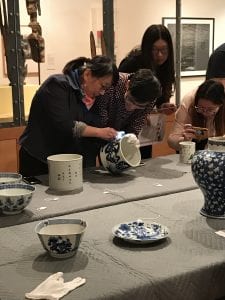There is something for everyone within Lehigh University Art Galleries (LUAG) Teaching Collection. Professor Dongning Wang (Adjunct Lecturer, Modern Languages and Literatures), took that phrase to heart during the Spring 2018 Semester and actively incorporated pieces from the Chinese Ceramics Collection into her course ASIA, MLL 197-10, also known as Pottery and Porcelain: History, Culture, and Technology along the Silk Road. The focus of the course was to examine Chinese porcelain in its’ cultural and historical context and the international porcelain trade in East Asia, Central Asia, and Europe. Using the LUAG Teaching Collection she was able to provide her students with the opportunity to study physical examples of the ceramics that they discussed in class.
The Chinese Ceramics Collection contains over a hundred artifacts, containing pieces that are representational of time periods such as the Neolithic Period, the Han Dynasty, the Qing Dynasty and more. With such a large collection and time period to pick from, Dr. Wang had to create parameters for what she wanted her students to see. The course focuses on the Silk Road, a network of trade routes that were formally established during the Han Dynasty (206 BC – 220 AD) which linked the regions of the ancient world together through commerce and was used until the 1450s. With this in mind, Dr. Wang worked closely with LUAG Head Preparator, Jeffery Ludwig-Dicus, to curate a broad selection of pieces that demonstrated the advancements in ceramic techniques throughout Chinese history. The selected pieces were representational of four overarching themes: the development of pottery, sculptures and figurines, monochrome objects, and blue and white objects. The pieces that demonstrated the development of pottery from its’ early beginnings to proto-porcelain stages, allowed students to study the evolution in composition, shape, color, and function. The sculptures and figurines that were created during the time period spanning the Qin Dynasty to the Tang Dynasty demonstrated the changing ideas of life after death. Monochrome objects, demonstrated the advancements in glazing techniques and the creation of kilns that allowed objects to be fired at a high temperature. The blue and white objects, from the later Ming Dynasty and Qing Dynasty of the 17th-19th centuries, illustrated how the growth of the porcelain trade led to the exchange of technological advancements and the increase of outside influence on Chinese ceramic design.
Dr. Wang and her students met three times throughout the Spring 2018 semester in the LUAG Lower Gallery to study the selected ceramics. Dr. Wang said that she was thrilled that her students would have the opportunity to see examples of changing ceramic techniques and technologies right here on Lehigh’s campus and her students were appreciative of the opportunity to deepen their learning experience. Austin Feng Wang said that being able to examine the physical object “far surpassed seeing the pieces on a screen” and he “loved walking down the stairs knowing that a thousand years of history awaited me on the tables at the bottom.” Yujain Song stated that she “felt it definitely helped me to have a better understanding toward the pottery and glaze.” These students and their classmates had a hands-on opportunity to study over 4,000 years of advancements and changes in the field of ceramics. Although these objects were chosen because they spoke directly to the what the students were learning in the course, Dr. Wang feels confident that they could be used to study topics ranging from Asian culture to global trade history.
After three visits to the LUAG Lower Gallery students were asked to pick two objects to compare and contrast for their final class presentations. The final presentations, a culmination of weeks’ worth of research, were presented to the rest of the class, Dr. Wang, and members of the LUAG staff. The students’ findings were then turned over to LUAG for further research and to eventually be added into LUAG’s records. Not only did the students in Dr. Wang’s ASIA, MLL 197 – 10 course provide LUAG with more information on various pieces of the collection, they also insured that the students after them would have a deeper understanding of the significance of these pieces. In this way, Dr. Wang’s students left their own personal marks on the LUAG collection and provided an incredible contribution to Lehigh University.
The Chinese Ceramics Collection is only a small portion of the permanent collection. LUAG’s Teaching Collection is comprised of over 15,000 objects that cover a wide range of time periods, mediums, movements, and areas of the world. Anyone looking to provide their students with a similar experience or to learn how to incorporate LUAG’s exhibitions into their courses are strongly encouraged to reach out for more information.





